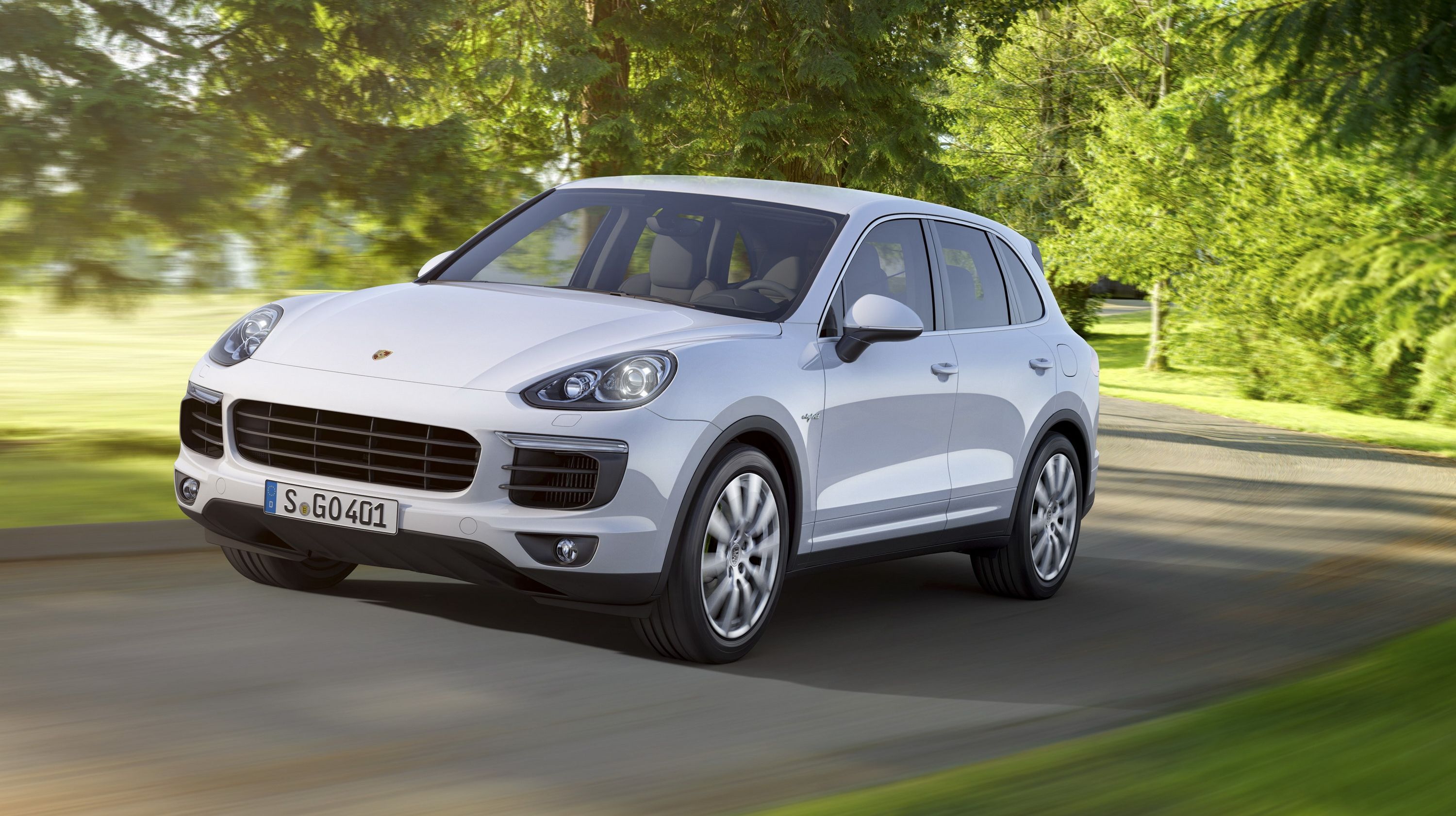Porsche->ke1 announced plans to introduce a hybrid version of the Cayenne->ke212 in 2005, three years after it had launched its sports SUV.->ke145 A functioning vehicle was shown at the 2007 Frankfurt Motor Show,->ke235 with the production version, dubbed S Hybrid, arriving three years later. Brought to the United States in late 2010, the S Hybrid was motivated by a supercharged, 3.0-liter, V-6, gasoline engine and an electric motor that cranked out a total of 380 horsepower and 428 pound-feet of torque. As the second-gen Cayenne received its facelift for the 2015 model year, the Germans announced the launch of the S E-Hybrid, a plug-in model set to replace the S Hybrid.
More powerful, fuel-efficient, and eco-friendly when compared to its predecessor, the S E-Hybrid is also the first plug-in hybrid in the premium-SUV segment. What's more, the revised hybrid also enables Porsche to become the first manufacturer to sell three production plug-in hybrids. The Cayenne joins the plug-in version of the Panamera->ke1840 sports sedan->ke142 and the 918 Spyder->ke3629 supercar.->ke177
The Cayenne S E-Hybrid makes its official debut at the 2014 Paris Motor Show.->ke227
Click past the jump to read more about Porsche Cayenne S E-Hybrid.
2015 Porsche Cayenne S E-Hybrid
- Make: Array
- Model: 2015 Porsche Cayenne S E-Hybrid
- Engine/Motor: V6
- Horsepower: 416 @ 3300
- Torque: 435 @ 1250
- [do not use] Vehicle Model: Array
Exterior
The Cayenne S E-Hybrid benefits from all the visual tweaks introduced with the 2015 Cayenne facelift. These include a redesigned front bumper with a larger grille and side dams, new headlamps with four-point LED daytime running lights, and revised fog lamps. Improvements are also noticeable around back, where brand-new taillights replace the previous units and new-design exhaust pipes are integrated into the diffuser.
All told, the S E-Hybrid is identical to its gasoline and diesel Cayenne siblings save for "Hybrid" badges placed on its front fenders and tailgate.
Interior
Same goes for the interior, which comes with all the updates introduced on the entire 2015 Cayenne lineup. Of course, the infotainment system and the instrument cluster feature different displays and functions, but everything else remains unchanged. No need to be disappointed though, as the 2015 Cayenne has received numerous updates, including a brand-new, multifunction steering wheel and revised rear seats for better comfort.
Just like its predecessor, the facelifted SUV is packed with luxury and convenience features, with nearly every inch of the cabin covered by high-quality leather and Alcantara.
Drivetrain
The Cayenne S E-Hybrid is powered by the same drivetrain offered in its predecessor, but output has been increased by means of an updated electric motor. Now rated at 95 ponies, 48 more than the electric unit available in the Cayenne S Hybrid, the motor mates to Porsche's proven, supercharged, 3.0-liter V-6 that's rated at 333 horses for a total output of 416 horsepower at 5,500 rpm and 435 pound-feet of torque at 1,250 rpm. Overall, the S E-Hybrid showcases a 36-horsepower and 7-pound-feet improvement over the outgoing model.
Naturally, more power means better performance, which is why the Cayenne S E-Hybrid needs only 5.4 seconds to complete the 0-to-60 mph sprint and comes with a top speed of 151 mph. While the 0-to-60 mph benchmark sees a massive improvement from the previous model's 6.1 seconds, top speed remains nearly identical to he S Hybrid's, which topped out at 150 mph. Top speed drops dramatically when the S E-Hybrid goes into electric-only mode, with the plug-in hybrid reaching only 77 mph.
As far as fuel efficiency is concerned, the updated Cayenne hybrid needs only 3.4 liters of gasoline to cover 100 km on the European cycle. U.S. mpg figures have yet to be released, and we'll have to wait for the EPA to publish its results for the official numbers. We can, however, look at the European efficiency rating, which converts to a whopping 69 mpg. More efficient than its predecessor, the new hybrid is also friendlier with the environment. The SUV emits only 79 grams of CO2 per km, compared to the previous model's 193 g/km. Now that's a huge improvement!
Prices
The 2015 Cayenne S E-Hybrid retails from $76,400 before options in the United States, making it $5,500 more expensive than the S Hybrid model it replaces. Pricing-wise, the hybrid sits between the Cayenne S and the Cayenne Turbo.
Competitors
Audi Q7 Plug-In Hybrid
Ironically, the Cayenne S E-Hybrid's main rival comes from under the same Volkswagen umbrella. Specifically, it's built by Audi, which, just like Porsche, is owned by Volkswagen Group. The vehicle in question is the Q7 Plug-in Hybrid, which is scheduled to arrive for the 2016 model year. The first hybrid SUV ever to come out of Ingolstadt, the Q7 Plug-in is likely to benefit from the Cayenne S E-Hybrid's drivetrain, meaning a supercharged, 3.0-liter, V-6 engine and an electric motor.
Details are still under wraps as of September 2014, but word on the street has it the combo will pump more power into the Q7, meaning the Audi might be the more powerful of the two. However, we expect the Q7 to lag behind the Cayenne in terms of performance.
Volkswagen Touareg
The Touareg Hybrid is the third hybrid SUV coming from the Volkswagen Group. It features the same supercharged V-6 as the Cayenne and the Q7, but its electric motor comes in the pre-facelift Cayenne form, meaning it cranks out only 47 ponies. The combo makes the Touareg Hybrid good for 380 horsepower and 428 pound-feet of torque, which puts it on par with the 2014 Cayenne S Hybrid. The drivetrain mates to an eight-speed automatic transmission and returns 24 mpg on the highway and 20 mpg in the city.
Granted, the Touareg Hybrid is not as fast as the Porsche Cayenne S E-Hybrid or the upcoming Audi Q7 Plug-In Hybrid, but its $64,745 starting prices makes it the most affordable option of the group.
Conclusion
The Cayenne S E-Hybrid is everything we hoped it would be. It comes with all the visual enhancements introduced by the facelifted, second-generation SUV and a more powerful electric motor on top. More powerful and quicker that its predecessor, the S E-Hybrid is also a lot more friendlier to the environment, emitting less than half the quantity of carbon-dioxide it did until 2014. The Euro-cycle fuel economy figures also suggest the new hybrid is also more efficient, an outstanding feat considering its updated drivetrain.




